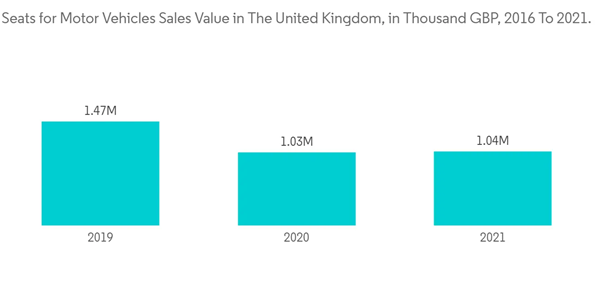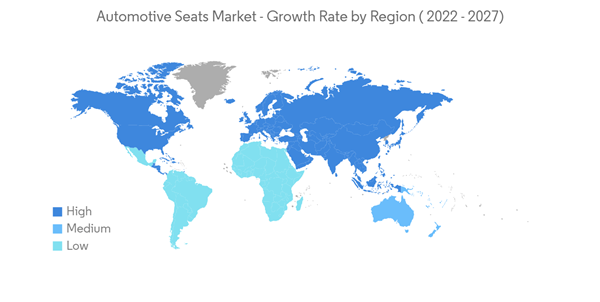Currently, the Automotive Seat Market was valued at USD 80.25 billion, and it is expected to reach 109.2 billion growing at a CAGR of 5.27% in the upcoming five years.
The COVID-19 pandemic hindered the growth of the automotive seat market as there were continuous lockdowns and travel restrictions across the world to contain the virus. In addition, the market's supply chain got affected as manufacturing units were shut down. However, post-pandemic, the situation has gotten better with increasing sales of motor vehicles.
Over the long term, new opportunities in the automotive seat market are being created by the increasing use of lightweight materials to reduce seat weight. During the forecast period, the automotive seat markets will be fueled by rising SUV demand and rising vehicle production. The market is also being driven by rising demand for climate-controlled seat technology and lightweight seat frames.
Furthermore, the high costs of modular and advanced seats in comparison to traditional seats may stifle the growth of the automotive seat market. However, the increasing use of lightweight materials to reduce the weight of automotive seats is opening up new opportunities in the automotive seat market. Rising SUV demand and rising vehicle production will drive the automotive seat markets during the forecast period. Moreover, the companies are also using leather seats for the customers choosing leather seats for their comfort.
The Asia-Pacific region is expected to exhibit a better growth rate during the forecast period, as manufacturers are actively setting up bases in emerging markets such as India and China to take advantage of the low labor costs. This trend may change the dynamics of the industry in the long run, and seat manufacturers may have to start setting up facilities in these emerging markets to stay competitive.
However, technological advancements have resulted in the development of climate-controlled seating technology in automobile seats, allowing consumers to cool them immediately. In order to accomplish this, these seats have perforated inserts with chillers and fans built into them. Similarly, there are fabric-based heaters in the seats, which are useful in cold weather. As a result, there is a growing emphasis on providing climate-controlled seats. Powered, heated, and ventilated applications are now commercialized and used in many low-cost vehicles.
The big companies operating in this automotive seat market use various strategies to aid in proliferation with the integration of electrical components, thus increasing comfort. They provide a variety of functions, such as ventilation, heating, and massaging. Another important factor aiding the increasing penetration of technology in the automotive seat market is automated seat adjustment using sensors to ensure comfort. For instance,
The growing demand for affordable vehicles in Asian countries such as China, Japan, South Korea, and India can be attributed to shifts in consumer behavior caused by pandemics. China is expected to be the region's fastest-growing automotive seat market due to increased vehicle production and sales.
The demand for powered and heated seats is expected to grow in this region, owing to the increasing demand for technologically advanced features by customers; China, as the global automotive manufacturing hub, has a large number of industry participants, with the majority of foreign industry leaders forming joint ventures and acquisitions with local manufacturers. For instance, in
Furthermore, India is the Asia-Pacific region's fastest-growing automotive market. Vehicle sales in the country fell dramatically as a result of the pandemic. Nonetheless, as the situation stabilized, vehicle sales and demand increased significantly and are expected to continue during the forecast period, assisting the automotive seat market in growing in the coming years. For instance, in 2020, 2.9 million cars were sold in India, which climbed to 3.8 million units last year.
This product will be delivered within 2 business days.
The COVID-19 pandemic hindered the growth of the automotive seat market as there were continuous lockdowns and travel restrictions across the world to contain the virus. In addition, the market's supply chain got affected as manufacturing units were shut down. However, post-pandemic, the situation has gotten better with increasing sales of motor vehicles.
Over the long term, new opportunities in the automotive seat market are being created by the increasing use of lightweight materials to reduce seat weight. During the forecast period, the automotive seat markets will be fueled by rising SUV demand and rising vehicle production. The market is also being driven by rising demand for climate-controlled seat technology and lightweight seat frames.
Furthermore, the high costs of modular and advanced seats in comparison to traditional seats may stifle the growth of the automotive seat market. However, the increasing use of lightweight materials to reduce the weight of automotive seats is opening up new opportunities in the automotive seat market. Rising SUV demand and rising vehicle production will drive the automotive seat markets during the forecast period. Moreover, the companies are also using leather seats for the customers choosing leather seats for their comfort.
The Asia-Pacific region is expected to exhibit a better growth rate during the forecast period, as manufacturers are actively setting up bases in emerging markets such as India and China to take advantage of the low labor costs. This trend may change the dynamics of the industry in the long run, and seat manufacturers may have to start setting up facilities in these emerging markets to stay competitive.
Automotive Seats Market Trends
Rising Demand for Climate-controlled Seat Technology
The increasing global warming at extreme temperatures complicates vehicle travel for drivers and passengers. Due to the increasing climate and environmental challenges, the automotive seat market is expected to accommodate new technologies. For example, if a passenger car is left in the sun all day, the trapped heat will make it uncomfortable for the passenger and driver to sit in the car.However, technological advancements have resulted in the development of climate-controlled seating technology in automobile seats, allowing consumers to cool them immediately. In order to accomplish this, these seats have perforated inserts with chillers and fans built into them. Similarly, there are fabric-based heaters in the seats, which are useful in cold weather. As a result, there is a growing emphasis on providing climate-controlled seats. Powered, heated, and ventilated applications are now commercialized and used in many low-cost vehicles.
The big companies operating in this automotive seat market use various strategies to aid in proliferation with the integration of electrical components, thus increasing comfort. They provide a variety of functions, such as ventilation, heating, and massaging. Another important factor aiding the increasing penetration of technology in the automotive seat market is automated seat adjustment using sensors to ensure comfort. For instance,
- October, 2022 : NHK Spring Co. Ltd (NHK Spring) concentrated on creating automobile seats that reduce motion sickness. In order to lessen motion sickness in vehicles, the business has created a headrest with an innovative structure and hand support for using a smartphone. Its efficacy has already been established. In preparation for automated driving technology's gradual commercialization, the company seeks to enhance its value.
The Asia-Pacific Region to Lead the Market
During the forecast period, the Asia-Pacific region is expected to lead the market for automotive seats. Because of the presence of leading automotive seating manufacturers in the region, China is expected to hold a significant market share.The growing demand for affordable vehicles in Asian countries such as China, Japan, South Korea, and India can be attributed to shifts in consumer behavior caused by pandemics. China is expected to be the region's fastest-growing automotive seat market due to increased vehicle production and sales.
The demand for powered and heated seats is expected to grow in this region, owing to the increasing demand for technologically advanced features by customers; China, as the global automotive manufacturing hub, has a large number of industry participants, with the majority of foreign industry leaders forming joint ventures and acquisitions with local manufacturers. For instance, in
- October, 2022 : Magna announced a joint venture with Guangdong Huatie Tongda High-Speed Railway Equipment Corporation in Qingdao, Shandong, to provide seating system solutions for designated clients' New Energy Vehicles.
- November,2022 : Lear Corporation (Lear) made the strategic announcement of acquiring InTouch Automation, a supplier of complex automated testing equipment and Industry 4.0 technologies that are essential to the production of automotive seats. Lear's just-in-time (JIT) seating production process is enhanced by the InTouch product portfolio's standardization of testing procedures and increased capacity for real-time data collection and analysis.
Furthermore, India is the Asia-Pacific region's fastest-growing automotive market. Vehicle sales in the country fell dramatically as a result of the pandemic. Nonetheless, as the situation stabilized, vehicle sales and demand increased significantly and are expected to continue during the forecast period, assisting the automotive seat market in growing in the coming years. For instance, in 2020, 2.9 million cars were sold in India, which climbed to 3.8 million units last year.
Automotive Seats Market Competitor Analysis
The automotive seat market is mainly dominated by Aisin Seiki Co. Ltd, Toyota Boshoku Corporation, Adient, Lear Corporation, Magna, Faurecia, Achi Co. Ltd, and IFB Industries Limited. With innovation gaining focus in the automotive seat market, many companies are coming together to research and develop innovative and novel automotive seating solutions. For instance,- December, 2022: Faurecia SE (Faurecia) announced that it has signed a development agreement with Indorama Ventures, a leader in the production and recycling of PET (polyethylene terephthalate), to create a new line of cushioning solutions called 'Auraloop' for the mobility market that is constructed from a structure of 100% recyclable polyester-based fibers. The new reasonable material in Auraloop will twofold lessen the carbon impression of vehicle seat cushions, presently produced using polyurethane froth. Auraloop's improved breathability and permeability for air, as well as its improved passive thermal regulation of occupants, make it a more comfortable seating option than current seating pad options.
Additional benefits of purchasing the report:
- The market estimate (ME) sheet in Excel format
- 3 months of analyst support
This product will be delivered within 2 business days.
Table of Contents
1 INTRODUCTION
4 MARKET DYNAMICS
5 MARKET SEGMENTATION (Market Size in USD Billion)
6 COMPETITIVE LANDSCAPE
Companies Mentioned (Partial List)
A selection of companies mentioned in this report includes, but is not limited to:
- Adient PLC
- Lear Corp.
- Faurecia SE
- Toyota Boshoku Corporation
- Magna International Inc.
- Aisin Corporation
- NHK SPRING Co. Ltd
- Grupo Antolin
- Recaro Holding
- TS Tec Co. Ltd
Methodology

LOADING...










